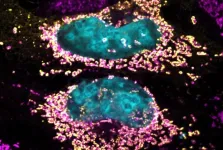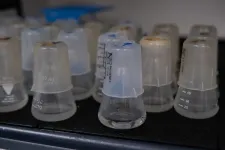(Press-News.org) An analysis of beeswax in managed honeybee hives in New York found a wide variety of pesticide, herbicide and fungicide residues – exposing current and future generations of bees to long-term toxicity.
The study, published in the Journal of Veterinary Diagnostic Investigation, notes that people may be similarly exposed through contaminated honey, pollen and wax in cosmetics. Though the chemicals found in wax are not beneficial to humans, the small amounts in these products are unlikely to pose a major risk to human health, as compared to their impact on bees.
Bees reuse wax over years, causing chemicals to accumulate, including those that are no longer in use in New York but remain in beeswax.
“Because pesticides can accumulate in wax, it’s important for beekeepers to keep removing old wax every few years and having the bees replace it to make sure the colonies and the bee products remain healthy,” said Karyn Bischoff, associate professor of practice at Cornell University and the study’s lead author.
Toxic residues get into beeswax from nectar and pollen of plants that have been sprayed with pesticides, and from drugs and pesticides that beekeepers apply to hives to improve bee health. Healthy bees are vital to New York’s economy and agriculture: the state’s beekeeping industry generated close to $11 million worth of honey in 2020 and annually generates $300 million in pollination services to agriculture.
Pesticides were found in all 72 managed honeybee colony samples analyzed and researchers tallied up to 34 fungicides, 33 insecticides and 22 herbicides, with each wax sample averaging about 18 residues. Wax sent by commercial beekeepers contained the most residues.
“Commercial beekeepers had the most pesticides, which makes sense because those bees are exposed to a lot of different crops, and farmers may use different pesticides for each,” Bischoff said.
The most common chemicals, found in 86% of samples, were acaricides – a class of insecticides that beekeepers use to protect honeybees from varroa mites. These mites are associated with very high bee losses over winter.
Almost every sample (98.6%) contained piperonyl butoxide, a compound that makes animals, insects and fungi more sensitive to insecticides and fungicides, making them more effective. Systemic insecticides (placed on seeds before planting and spreading to all parts of a plant as it grows), called neonics, were also common in samples.
Understanding which contaminants are impacting domestic honeybees may help researchers better protect other pollinators, including wild bees and other insects, as well as birds and bats, Bischoff said.
The New York State Environmental Protection Fund and the U.S. Department of Agriculture funded the research.
For additional information, read this Cornell Chronicle story.
Cornell University has dedicated television and audio studios available for media interviews.
- 30 -
END
Pesticides, herbicides, fungicides detected in New York state beeswax
2023-11-09
ELSE PRESS RELEASES FROM THIS DATE:
Study reveals bacterial protein capable of keeping human cells healthy
2023-11-09
Researchers at the University of São Paulo (USP) in Brazil, partnering with colleagues in Australia, have identified a novel bacterial protein that can keep human cells healthy even when the cells have a heavy bacterial burden. The discovery could lead to new treatments for a wide array of diseases relating to mitochondrial dysfunction, such as cancer and auto-immune disorders. Mitochondria are organelles that supply most of the chemical energy needed to power cells’ biochemical reactions.
An article on the study is published in the journal PNAS. The researchers ...
Endangered thick-billed parrots at risk of losing newly identified, unprotected Sierra Madre forest habitats to logging, deforestation, study shows
2023-11-09
DOWNLOAD PHOTOS AND VIDEO: https://sandiegozoo.box.com/s/x50kzaoukdtyjxsv9mzqgn0fu1m6kddk
A binational team of scientists, using creativity and innovation, adorned dozens of endangered thick-billed parrots with tiny solar-powered satellite transmitters to track and reveal their winter migratory nesting sites in the remote treetops of the Sierra Madre Occidental ranges. Their research reveals new critical habitat, 80% of which has no formal protection.
In a study published this month in the journal Global ...
Atomic dance gives rise to a magnet
2023-11-09
Quantum materials hold the key to a future of lightning-speed, energy-efficient information systems. The problem with tapping their transformative potential is that, in solids, the vast number of atoms often drowns out the exotic quantum properties electrons carry.
Rice University researchers in the lab of quantum materials scientist Hanyu Zhu found that when they move in circles, atoms can also work wonders: When the atomic lattice in a rare-earth crystal becomes animated with a corkscrew-shaped vibration known as a chiral phonon, the crystal is transformed ...
Milky Way-like galaxy found in the early universe
2023-11-09
Using the James Webb Space Telescope, an international team, including astronomer Alexander de la Vega of the University of California, Riverside, has discovered the most distant barred spiral galaxy similar to the Milky Way that has been observed to date.
Until now it was believed that barred spiral galaxies like the Milky Way could not be observed before the universe, estimated to be 13.8 billion years old, reached half of its current age.
The research, published in Nature this week, was led by scientists at the Centro de Astrobiología in Spain.
“This galaxy, named ceers-2112, formed soon after ...
Side-effect avoiding treatment shows early promise against breast cancer in mice
2023-11-09
New experimental evidence suggests that substances known as narrow-spectrum Wnt signaling inhibitors—which could have fewer side effects than other related substances—are capable of suppressing the growth of breast cancer tumors in mice. Aina He of Shanghai Jiaotong University Affiliated Sixth People’s Hospital, China, and colleagues present these findings November 9th in the open access journal PLOS Biology.
While certain subtypes of breast cancer can be targeted with special medications, others can only be treated with standard chemotherapy. For some patients, chemotherapy may lead to the growth of stem cell-like cancer cells that are drug resistant. Previous ...
Bacteria-virus arms race provides rare window into rapid and complex evolution
2023-11-09
As conceived by Charles Darwin in the 1800s, evolution is a slow, gradual process during which species adaptations are inherited incrementally over generations. However, today biologists can see how evolutionary changes unfold on much more accelerated timescales.
Rather than the evocative plants and animals of the Galapagos Islands that Darwin studied in forming his theory of evolution, Postdoctoral Scholar Joshua Borin and Associate Professor Justin Meyer of UC San Diego’s School of Biological Sciences are documenting rapid evolutionary processes in simple laboratory flasks.
Borin ...
Open-science “COVID Moonshot” discovers new antivirals to treat COVID-19
2023-11-09
Although the group’s work has been freely available since its inception in March 2020, the COVID Moonshot Consortium is finally formally reporting their results. The COVID Moonshot – an open-science, crowdsourced, and patent-free drug discovery campaign targeting the SARS-CoV-2 virus – has yielded a wealth of data on the virus’s main protease, including insights that could pave the way for the development of new and better therapeutics. “The lead therapeutics described by [these researchers] may not be ready in time to affect the current pandemic, considering the timelines and challenges of drug approval,” write Brian Shoichet and Charles ...
Shrinking a mode-locked laser to the size of an optical chip
2023-11-09
Setting out to improve a technology that usually requires bulky, bench-top equipment, Quishi Guo and colleagues have shrunk a mode-locked laser (MLL) to the size of an optical chip with an integrated nanophotonic platform. The results show promise for developing ultrafast nanophotonic systems for a wide range of applications. Mode-locked lasers (MLLs) can produce coherent ultrashort pulses of light at extremely fast speeds – on the order of picoseconds and femtoseconds. These devices have enabled numerous technologies in photonics, including extreme nonlinear optics, two-photon microscopy, ...
Wildfire risk to US homes is rising, especially in western grasslands and shrublands
2023-11-09
Drawing on 30 years of data, researchers show that the number of homes within wildfire perimeters in the U.S. has doubled since the 1990s. This increasing risk is driven by both an increase in wildfires and the expansion of new homes into wildfire-prone areas, especially in the wildland-urban interface. Wildfire risks to homes are increasing, particularly in the wildland-urban interface (WUI), where houses and wildland vegetation are in close proximity. Over the last 12 years, more than 55,000 homes in the U.S. have been lost to wildfires due to rapid increases ...
Introducing: Ceramic- and glass-based passive radiative cooling materials resistance to harsh environments
2023-11-09
Two studies highlight new glass- and ceramic-based passive radiative cooling materials. Unlike passive radiative cooling approaches that rely on polymers, these hard materials are more durable and versatile, making them more attractive for a wide range of outdoor passive cooling applications, including those that could help reduce the need for air conditioning. The energy demand for cooling continues to rise, particularly in regions rapidly warming due to climate change. To make matters worse, the growing carbon footprint of cooling systems further contributes to global warming, exacerbating the need for cooling solutions. Passive radiative cooling (PRC) materials, which ...




